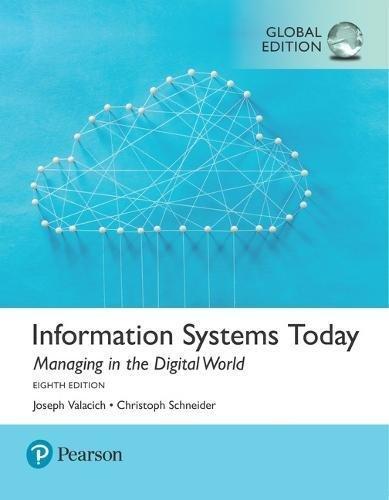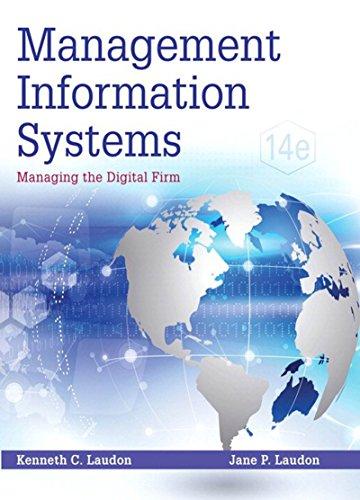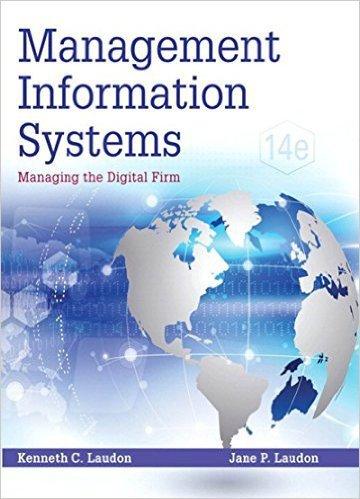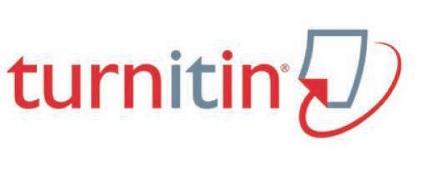Brief Contents
Preface 19
Chapter 1 Managing in the Digital World 30
Chapter 2 Gaining Competitive Advantage Through Information Systems 76
Chapter 3 Managing the Information Systems Infrastructure and Services 118
Chapter 4 Enabling Business-to-Consumer Electronic Commerce 166
Chapter 5 Enhancing Organizational Communication and Collaboration Using Social Media 210
Chapter 6 Enhancing Business Intelligence Using Big Data and Analytics 252
Chapter 7 Enhancing Business Processes Using Enterprise Information Systems 298
Chapter 8 Strengthening Business-to-Business Relationships via Supply Chain and Customer Relationship Management 334
Chapter 9 Developing and Acquiring Information Systems 372
Chapter 10 Securing Information Systems 418
Technology Briefing Foundations of Information Systems Infrastructure 470
Acronyms 519
Glossary 521
Name Index 541
Organization Index 542
Subject Index 545
This page intentionally left blank
Preface 19
Chapter 1 Managing in the Digital World 30
MANAGING IN THE DIGITAL WORLD: Open Innovation 30
Information Systems Today 32
The Emergence of the Digital World 32
Globalization and Societal Issues in the Digital World 35
◾ COMING ATTRACTIONS: Memory Crystals 35
Five IT Megatrends That Shape the Digital Future 38
◾ WHO’S GOING MOBILE: Wearable Technologies 38
◾ GREEN IT: The Green Internet of Things 44
Information Systems Defined 44
Data: The Root and Purpose of Information Systems 46
Hardware, Software, and Telecommunications Networks: The Components of Information Systems 46
People: The Builders, Managers, and Users of Information Systems 47
◾ SECURITY MATTERS: Ransomware 52
Organizations: The Context of Information Systems 53
◾ WHEN THINGS GO WRONG: Technology Addiction 56
The Dual Nature of Information Systems 57
Case in Point: An Information System Gone Awry: Outages Outrage Gamers 57
Case in Point: An Information System That Works: FedEx 57
Information Systems for Competitive Advantage 58
◾ ETHICAL DILEMMA: The Social and Environmental Costs of the Newest Gadgets 59
IS Ethics 60
Information Privacy 60
Intellectual Property 64
The Need for a Code of Ethical Conduct 65
◾ INDUSTRY ANALYSIS: Business Career Outlook 66
Key Points Review 67 • Key Terms 67 • Review Questions 68 • SelfStudy Questions 68 • Problems and Exercises 69 • Application Exercises 70 • Team Work Exercise 70 • Answers to the Self-Study Questions 71
◾ APPLE 72
◾ HEALTHCARE IS 73
Chapter 2 Gaining Competitive Advantage Through Information Systems 76
MANAGING IN THE DIGITAL WORLD: Startups and New Business Models 76
Enabling Organizational Strategy through Information Systems 78
Organizational Decision-Making Levels 78
Organizational Functional Areas 80
Information Systems for Automating: Doing Things Faster 81
Information Systems for Organizational Learning: Doing Things Better 83
Information Systems for Supporting Strategy: Doing Things Smarter 84
Identifying Where to Compete: Analyzing Competitive Forces 84
Identifying How to Compete: Choosing a Generic Strategy 85
Identifying How to Compete: Resources and Capabilities 86
◾ GREEN IT: The Electric Navy 87
Identifying How to Compete: Analyzing the Value Chain 88
The Role of Information Systems in Value Chain Analysis 88
The Technology/Strategy Fit 89
Business Models in the Digital World 89
◾ WHO’S GOING MOBILE: Digital Nomads 90
Revenue Models in the Digital World 90
◾ WHEN THINGS GO WRONG: The Pains of Uber in China 93
Platform-Based Business Models and the Sharing Economy 93
Service-Based Business Models 95
◾ ETHICAL DILEMMA: The Ethics of the Sharing Economy 96
Valuing Innovations 97
The Need for Constant IS Innovation 99
Successful Innovation Is Difficult 100
Open Innovation 101
Organizational Requirements for Innovation 102
◾ COMING ATTRACTIONS: The CITE Project 103
The Innovation Process 103
◾ SECURITY MATTERS: The Bangladesh SWIFT Theft 106 Startups and Crowdfunding 106
◾ INDUSTRY ANALYSIS: Education 108
Key Points Review 109 • Key Terms 109 • Review Questions 110 • SelfStudy Questions 110 • Problems and Exercises 111 • Application Exercises 112 • Team Work Exercise 112 • Answers to the Self-Study Questions 112
◾ LINKEDIN 113
◾ STREAMING VIDEO 114
Chapter 3 Managing the Information Systems Infrastructure and Services 118
MANAGING IN THE DIGITAL WORLD: From Google to Alphabet 118 The IS Infrastructure 120
◾ WHO’S GOING MOBILE: Mobile Payments Are Transforming Developing Countries 122
Applications and Databases Supporting Business Processes 124
◾ ETHICAL DILEMMA: Putting People’s Lives Online 125
IS Infrastructure Components 126
Hardware 126
System Software 128
Storage 130
◾ COMING ATTRACTIONS: Making Death Optional? 130
Networking 131
◾ GREEN IT: Alphabet Renewables 137
Data Centers 139
Issues Associated with Managing the IS Infrastructure 140
Rapid Obsolescence and Shorter IT Cycles 140
Big Data and Rapidly Increasing Storage Needs 143
Demand Fluctuations 143
Increasing Energy Needs 144 Cloud Computing 144
◾ �WHEN THINGS GO WRONG: Old and Dirty Energy Drives Global Internet Growth 145
What Is Cloud Computing? 145
Managing the Cloud 149
Advanced Cloud Applications 152
◾ SECURITY MATTERS: Car Hacking 154
Green Computing 157
◾ INDUSTRY ANALYSIS: Movie Industry 158
Key Points Review 159 • Key Terms 159 • Review Questions 160 • SelfStudy Questions 160 • Problems and Exercises 161 • Application Exercises 162 • Team Work Exercise 162 • Answers to the Self-Study Questions 163
◾ DBS SINGAPORE MOVES TO THE CLOUD 163
◾ THE DARK WEB 164
Chapter 4 Enabling Business-to-Consumer Electronic Commerce 166
MANAGING IN THE DIGITAL WORLD: Taobao and the World of E-commerce 166
E-Commerce and E-Government 168
Types of Electronic Commerce 168
E-government 169
E-finance 170
Business-To-Consumer E-Commerce 171
◾ COMING ATTRACTIONS: The AI Hedge Fund 172
E-tailing: Capabilities and Opportunities 174 Benefits of E-tailing 177
◾ ETHICAL DILEMMA: The Ethics of Reputation Management 178 Drawbacks of E-tailing 179
Electronic Commerce Websites and Internet Marketing 179
Designing Websites to Meet Online Consumers’ Needs 180
◾ SECURITY MATTERS: Too Small to Be Hacked? 180
Internet Marketing 182
◾ WHEN THINGS GO WRONG: Buying Likes 186
Mobile Commerce, Consumer-To-Consumer EC, and Consumer-To-Business EC 187
C2C EC 189
C2B EC 190
Securing Payments and Navigating Legal Issues in EC 191
Securing Payments in the Digital World 191
◾ GREEN IT: Green Online Shopping 192
◾ WHO’S GOING MOBILE: Mobile Payments 193
Legal Issues in EC 196
◾ INDUSTRY ANALYSIS: Retailing 199
Key Points Review 200 • Key Terms 200 • Review Questions 201 • SelfStudy Questions 201 • Problems and Exercises 202 • Application
Exercises 203 • Team Work Exercise 203 • Answers to the Self-Study
Questions 204
◾ WEB ANALYTICS 205
◾ ROCKET INTERNET—CLONING BUSINESS MODELS 206
Chapter 5 Enhancing Organizational Communication and Collaboration Using Social Media 210
MANAGING IN THE DIGITAL WORLD: Facebook 210
The Need for Communication and Collaboration 212
Virtual Teams 212
Groupware 213
Videoconferencing 214
◾ GREEN IT: Green IT Fueling Renewable Energy 216
Intranets and Employee Portals 216
The Evolving Web 218
◾ COMING ATTRACTIONS: Dissolvable Electronics 219
Evolving Web Capabilities 219
Evolving Social Interaction 220
The Evolving Workspace 221
Future Web Capabilities 221
Social Media and the Enterprise 222
Enhancing Communication Using Social Media 222
Enhancing Cooperation with Social Media 225
◾ SECURITY MATTERS: Terrorism Is Winning the Social Media Battle 228
Enhancing Collaboration with Social Media 229
◾ WHO’S GOING MOBILE: Going SoLoMo: Yelp 231
Enhancing Connection with Social Media 233
◾ ETHICAL DILEMMA: Anonymity, Trolling, and Cyberharassment 235
Managing Social Media Applications in the Enterprise 236
Organizational Issues 236
◾ WHEN THINGS GO WRONG: Crowdfunding Failures 238
Downsides and Dangers of using Social Media Applications 239
◾ INDUSTRY ANALYSIS: Online Travel 241
Key Points Review 242 • Key Terms 242 • Review Questions 243 • SelfStudy Questions 243 • Problems and Exercises 244 • Application
Exercises 244 • Team Work Exercise 245 • Answers to the Self-Study
Questions 246
◾ LIVING IN A BUBBLE: FACEBOOK, NEWSFEEDS, AND JOURNALISM 246
◾ LIKE FARMING AND CLICKBAIT 247
Chapter 6 Enhancing Business Intelligence Using Big Data and Analytics 252
MANAGING IN THE DIGITAL WORLD: Intelligence Through Drones 252
Enhancing Organizational Decision Making 254
Why Organizations Need Business Intelligence and Advanced Analytics 254
◾ �GREEN IT: Big Data, Internet of Things, and Analytics Fuel Greener Facilities 257
Databases: Providing Inputs into Business Intelligence and Advanced Analytics 257
◾ WHEN THINGS GO WRONG: Twitter Fever—Look Before You Tweet 261
◾ COMING ATTRACTIONS: Emotion Aware Gaming 267
Business Intelligence and Advanced Analytics 267
Business Intelligence 268
◾ WHO’S GOING MOBILE: Identifying Malaria Hotspots 273
Advanced Analytics 273
◾ ETHICAL DILEMMA: Orwellian Internet of Things 275
◾ �SECURITY MATTERS: Hacktivists Versus Fembots: The Ashley Madison Case 281
Knowledge Management and Geographic Information Systems 282
Knowledge Management Systems 282
Geographic Information Systems 285
◾ INDUSTRY ANALYSIS: Healthcare 288
Key Points Review 289 • Key Terms 289 • Review Questions 290 • SelfStudy Questions 290 • Problems and Exercises 291 • Application Exercises 292 • Team Work Exercise 293 • Answers to the Self-Study Questions 293
◾ DATA ANALYTICS IN HEALTHCARE 293
◾ GATHERING SOCIAL INTELLIGENCE 294
Chapter 7 Enhancing Business Processes Using Enterprise Information Systems 298
MANAGING IN THE DIGITAL WORLD: Amazon.com 298
Core Business Processes and Organizational Value Chains 300
Core Business Processes 300
Organizational Activities Along the Value Chain 302
◾ GREEN IT: Why Your Enterprise Systems Should Be in the Cloud 305
Value Systems: Connecting Multiple Organizational Value Chains 307
Enterprise Systems 307
The Rise of Enterprise Systems 308
Supporting Business Processes 309
◾ ETHICAL DILEMMA: Too Much Intelligence? RFID and Privacy 310
◾ �COMING ATTRACTIONS: The Internet of Things Will Transform ERP and Organizations 313
Enterprise Resource Planning 316
Responding to Compliance and Regulatory Demands 317
Choosing an ERP System 317
◾ �SECURITY MATTERS: To Update or Not to Update, That Shouldn’t Be the Question 318
Enabling Business Processes Using ERP Core Components 319
ERP Installation 322
ERP Limitations 322
Achieving Enterprise System Success 322
◾ WHO’S GOING MOBILE: Big ERP Systems Embracing Small Mobile Devices 323
Secure Executive Sponsorship 323
Get Help from Outside Experts 324
Thoroughly Train Users 324
Take a Multidisciplinary Approach to Implementations 324
Evolve the Implementation 324
◾ �WHEN THINGS GO WRONG: Software Error Frees Prisoners Early and Is Linked to Killings 325
◾ INDUSTRY ANALYSIS: The Automobile Industry 326
Key Points Review 327 • Key Terms 327 • Review Questions 328 • SelfStudy Questions 328 • Problems and Exercises 329 • Application
Exercises 330 • Team Work Exercise 330 • Answers to the Self-Study Questions 330
◾ SOFTWARE AS A SERVICE: ERP BY THE HOUR 331
◾ TH MILK VIETNAM ADOPTS CLOUD ERP 332
Chapter 8 Strengthening Business-to-Business Relationships via Supply Chain and Customer Relationship Management 334
MANAGING IN THE DIGITAL WORLD: Walmart 334
Supply Chain Management 336
What Is a Supply Chain? 336
Business-to-Business Electronic Commerce: Exchanging Data in Supply Networks 336
Managing Complex Supply Networks 339
Benefits of Effectively Managing Supply Chains 340
Optimizing the Supply Chain Through Supply Chain Management 342
◾ �WHEN THINGS GO WRONG: SpaceX Rocket Failure due to Supply Chain Failure 343
Developing an SCM Strategy 344
◾ GREEN IT: Nike’s Green Supply Chain 345
Supply Chain Planning 345
Supply Chain Execution 346
Supply Chain Visibility and Analytics 349
Customer Relationship Management 349
◾ COMING ATTRACTIONS: Augmenting Supply Chain Success 350
◾ �SECURITY MATTERS: Disclosing the Customer Data of the Most Vulnerable 353
Developing a CRM Strategy 353
Architecture of a CRM System 354
◾ WHO’S GOING MOBILE: Developing a Mobile CRM App for Customers 358
◾ ETHICAL DILEMMA: When Algorithms Discriminate 362
Ethical Concerns with CRM 363
◾ INDUSTRY ANALYSIS: Manufacturing 363 Key Points Review 364 • Key Terms 364 • Review Questions 365 • SelfStudy Questions 365 • Problems and Exercises 366 • Application Exercises 367 • Team Work Exercise 367 • Answers to the Self-Study Questions 367
◾ SUPPLY CHAIN HAVOC 368
◾ EFFICIENTLY DELIVERING PRODUCTS OVER THE “LAST MILE” 369
Chapter 9 Developing and Acquiring Information Systems 372
MANAGING IN THE DIGITAL WORLD: The Maker Movement 372 Making the Business Case 374
Business Case Objectives 374
The Productivity Paradox 374
Making a Successful Business Case 376
◾ GREEN IT: Project Natick—Microsoft’s Underwater Data Centers 378
◾ COMING ATTRACTIONS: Harvesting Human Energy 380
Presenting the Business Case 382
◾ ETHICAL DILEMMA: Ethical App Development 384
The Systems Development Process 385
Custom Versus Off-the-Shelf Software 385
Open Source Software 386
Systems Integration: Combining Custom, Open Source, and Off-the-Shelf Systems 387
IS Development in Action 387
The Role of Users in the Systems Development Process 389
Systems Development Controls 389
Steps in the Systems Development Process 389
◾ WHO’S GOING MOBILE: Creating Mobile Apps 390
Phase 1: Systems Planning and Selection 390
Phase 2: Systems Analysis 391
Phase 3: Systems Design 394
Phase 4: Systems Implementation and Operation 395
Repeating the SDLC: Systems Maintenance 397
◾ SECURITY MATTERS: Mobile Cybercrime 399
Other Approaches to Designing and Building Systems 399
Acquiring Information Systems 401
External Acquisition 401
◾ WHEN THINGS GO WRONG: Top Security Threats 402
Outsourcing Systems Development 406
◾ INDUSTRY ANALYSIS: Broadcasting 408
Key Points Review 409 • Key Terms 409 • Review Questions 410 • SelfStudy Questions 410 • Problems and Exercises 411 • Application Exercises 412 • Team Work Exercise 412 • Answers to the Self-Study Questions 413
◾ NEXT GENERATION IDENTIFICATION: FBI, ICE DATABASES EXPAND AND JOIN FORCES 414
◾ BIG DATA, HADOOP, MAP REDUCE 415
Chapter 10 Securing Information Systems 418
MANAGING IN THE DIGITAL WORLD: Not So “Anonymous”—Activists, Hacktivists, or Just Plain Criminals? 418
Computer Crime 420
Hacking and Cracking 420
Types of Computer Criminals and Crimes 420
◾ �GREEN IT: Anonymous Protests the Killing of Dolphins and Whales in Japan 424
Computer Viruses and Other Destructive Code 425
◾ �WHEN THINGS GO WRONG: The Bug That Almost Killed the Internet 430
Cyberharassment, Cyberstalking, and Cyberbullying 432
Software Piracy 432
Cybersquatting 434
Laws Against Computer Crime 434
Cyberwar and Cyberterrorism 435
◾ WHO’S GOING MOBILE: Backdoors in Every Mobile Phone? 436
Cyberwar 436
Cyberterrorism 437
◾ �ETHICAL DILEMMA: Ethics and Cyberwar: Just Because We Can, Should We? 440
Managing Information Systems Security 440
Assessing Risks 442
Developing a Security Strategy 444
Implementing Controls and Training 446
◾ �SECURITY MATTERS: Back to the Future: Analog May Be the Future of Securing Critical Infrastructure 447
◾ COMING ATTRACTIONS: Can You Become Your Password? 453
Monitoring Security 456
◾ INDUSTRY ANALYSIS: Cybercops Track Cybercriminals 459
Key Points Review 460 • Key Terms 460 • Review Questions 461 • SelfStudy Questions 461 • Problems and Exercises 462 • Application Exercises 464 • Team Work Exercise 464 • Answers to the Self-Study Questions 465
◾ SINGPASS E-GOVERNMENT SECURITY 466
◾ CHINA’S GREAT (FIRE) WALL 467
TECHNOLOGY BRIEFING
Foundations of Information Systems Infrastructure 470
Foundational Topics in IS Hardware 471
Input Technologies 471
Processing: Transforming Inputs into Outputs 473
Output Technologies 477
Foundational Topics in IS Software 478
System Software 479
Programming Languages and Development Environments 479
Foundational Topics in Networking 485
Evolution of Computer Networking 485
Types of Networks 487
Packet Switching 490
Network Standards and Protocols 490
Network Technologies 494
The Internet 500
Foundational Topics in Database Management 506
Relational Database Design 506
Advanced Database Models 511
Key Points Review 511
Questions 513
• Key Terms 512 • Review
• Self-Study Questions 514
• Problems and Exercises 515
Questions 517
Questions 517
Questions 517
Questions 517
Acronyms 519
Glossary 521
Name Index 541
Organization Index 542
Subject Index 545
• Answers to the Foundational Hardware Self-Study
• Answers to the Foundational Software Self-Study
• Answers to the Foundational Networking Self-Study
• Answers to the Foundational Database Self-Study
Approach
Information systems have become pervasive Mobile devices, social media, and cloud computing have transformed organizations and society. Organizations see the possibilities of the Internet of Things, in that not only computers but various sensors, motors, actuators, or even cameras can generate a wealth of potentially useful data. Businesses face unprecedented opportunities, but also challenges, through the ability to utilize Big Data. What does all this mean? What are the catalysts of these concepts and of all this change? More important, how can organizations thrive in this dynamic and highly competitive marketplace? The answer to these and many similar questions is that information systems and related information technologies are driving innovation, new business models, and hypercompetition. It is little wonder that teaching an introductory course on information systems has never been more crucial—or more challenging.
One of the greatest challenges that we face in teaching information systems courses is how to keep pace in the classroom with what is happening out in the real world. Being relevant to students while at the same time providing the necessary foundation for understanding the breadth, depth, and complexity of information systems has never been more difficult. We wrote Information Systems Today, Eighth Edition, with this overarching goal in mind, to be both rigorous and relevant. To accomplish this, we want students not only to learn about information systems but also to clearly understand the importance of information systems for individuals, organizations, and society. Additionally, we do not want to simply spoon-feed students with technical terms and the history of information systems. Instead, students must understand exactly what innovative organizations are doing with contemporary information systems and, more important, where things are heading. Finally, we want to empower students with the essential knowledge needed to be successful in the use and understanding of information systems in their careers.
To this end, we wrote Information Systems Today, Eighth Edition, so that it is contemporary, fun to read, and useful, focusing on what business students need to know about information systems to survive and thrive in the digital world.
Audience
Information Systems Today, Eighth Edition, is primarily for the undergraduate introductory information systems course required of all business students. The introductory information systems course typically has a diverse audience of students majoring in many different areas, such as accounting, economics, finance, marketing, general management, human resource management, production and operations, international business, entrepreneurship, and information systems. This book was also written for students studying topics outside of business, especially in the growing and broad area of information sciences. Given the range of students taking this type of course, we have written this book so that it is a valuable guide to all students, providing them with the essential information they need to know. Therefore, this book has been written to appeal to a diverse audience.
Information Systems Today, Eighth Edition, can also be used for the introductory course offered at the graduate level—for example, in the first year of an MBA program. Such usage would be especially appropriate if the course heavily focused on the diverse set of cases provided in each chapter.
What’s New to the Eighth Edition
Our primary goal for Information Systems Today, Eighth Edition, was to emphasize the importance of information systems to all business students as the role of information technology and systems continues to expand within organizations and society. Most notably, we extensively
examine how five big megatrends—mobile, social media, the Internet of Things, cloud computing, and Big Data—are transforming individuals, organizations, and society. Given this clear focus, we are better able to identify those topics most critical to students and future business professionals. Consequently, we have made substantial revisions to the basic content of the chapters and pedagogical elements as well as introduced several new elements that we believe help achieve this goal. New or expanded chapter topics include the following:
■ An extensively revised chapter—Chapter 1, “Managing in the Digital World”—focuses not only on defining what an information system consists of but also provides new content on globalization and societal issues in the digital world as well as the role of five IT megatrends in fueling and addressing these issues.
■ An extensively revised chapter—Chapter 2, “Gaining Competitive Advantage Through Information Systems”—provides new content describing how information systems play a key part in enabling different types of innovation and innovative business models.
■ A revised chapter—Chapter 3, “Managing the Information Systems Infrastructure and Services”—provides updated content on the need for a reliable, adaptable, and scalable infrastructure to support the needs of today’s organizations as well as on essential infrastructure concepts related to hardware, software, storage, networking and the Internet, data centers, and cloud computing.
■ A revised chapter—Chapter 4, “Enabling Business-to-Consumer Electronic Commerce”— provides updated content related to e-commerce involving the end consumer as well as new and expanded coverage of e-finance, fintech, and related issues.
■ A revised chapter—Chapter 5, “Enhancing Organizational Communication and Collaboration Using Social Media”—centers around various topics related to the need for organizational communication and provides updated content on how individuals and organizations use both traditional communication and collaboration tools and social media for communication, collaboration, cooperation, and connection.
■ An extensively revised chapter—Chapter 6, “Enhancing Business Intelligence Using Big Data and Analytics”—provides extended coverage on business intelligence and advanced analytics and greatly expanded content on machine learning, predictive modeling, artificial intelligence, unstructured data analytics, and spatial decision support.
■ A revised chapter—Chapter 8, “Strengthening Business-to-Business Relationships via Supply Chain and Customer Relationship Management”—provides updated content on business-to-business electronic commerce and supply chain management as well as customer relationship management (CRM).
■ A revised chapter—Chapter 9, “Developing and Acquiring Information Systems”— provides updates to various topics and extended content on alternative system development methodologies.
■ A revised chapter—Chapter 10, “Securing Information Systems”—provides an update to all topics and deeper coverage on industrial espionage and cyberterrorism.
■ A revised Technology Briefing covers foundational concepts related to various information technologies. The Technology Briefing provides the foundations for a deeper understanding of the topics introduced in Chapter 3 and is intended for use in more technically oriented courses. Each section of this briefing was designed to stand alone—it can be read with or without the other sections.
In addition to the changes within the main chapter content, we have also added two new features to each chapter—Green IT and Security Matters. Green IT presents environmental issues arising from the use of information systems. For example, in Chapter 4, we discuss the environmental impacts of online shopping. Security Matters presents some current issues and threats arising from the ubiquitous use of information systems. For example, in Chapter 5, we discuss how hacktivists challenged the extramarital dating website Ashley Madison.
Beyond the chapter content and features, we have also made substantial changes and refinements to the end of each chapter. In particular, we carefully revised many of the end-of-chapter problems and exercises to reflect content changes and new material. Further, we have carefully updated the end-of-chapter cases about contemporary organizations and issues to illustrate the complexities of the digital world. Each case mirrors the primary content of its chapter to better emphasize its relevancy within the context of a real organization. All these elements are discussed more thoroughly next.
Our goal has always been to provide only the information that is relevant to all business students, nothing more and nothing less. We believe that we have again achieved this goal with Information Systems Today, Eighth Edition. We hope you agree.
Key Features
As authors, teachers, developers, and managers of information systems, we understand that in order for students to best learn about information systems with this book, they must be motivated to learn. To this end, we have included a number of unique features to help students quickly and easily assess the true value of information systems and their impact on everyday life. We show how today’s professionals are using information systems to help modern organizations become more efficient and competitive. Our focus is on the application of technology to real-world, contemporary situations. Next, we describe each of the features that contribute to that focus.
Pedagogy—A Multitiered Approach
Each chapter provides a list of learning objectives to lay the foundation for the chapter content, followed by an opening case to highlight how contemporary organizations are utilizing information systems to gain competitive advantage, streamline organizational processes, or improve customer relationships or how information systems fuel societal change. In addition, throughout each chapter, various short pedagogical elements are presented to highlight key information systems issues and concepts in a variety of contexts. These elements help to show students the broader organizational and societal implications of various topics. At the end of each chapter, the Key Points Review repeats the learning objectives and describes how each objective was achieved; a variety of questions and exercises helps students assess their understanding of the chapter material and encourages them to synthesize and apply the concepts learned. A list of references appears at the end of each chapter.
OPENING CASE—MANAGING IN THE DIGITAL WORLD. Each chapter begins with an opening case describing a real-world company, technology, and/or issue to spark students’ interest in the chapter topic. We have chosen engaging cases that relate to students’ interests and concerns by highlighting why information systems have become central for managing in the digital world. Each opening case includes a series of associated questions the students will be able to answer after reading the chapter contents. The organizations, technologies, or issues highlighted in these cases are as follows:
■ The rise of open innovation
■ How information systems fuel startups and new business models
■ Google’s meteoric rise and its transition to Alphabet
■ How Chinese e-commerce company Taobao became a leader in the world of e-commerce
■ How Facebook has emerged as one of the most successful and powerful social media sites
■ Intelligence through drones
■ Amazon.com’s use of its sophisticated infrastructure to automate the supply chain for both large and small customers
■ How Walmart became a leader in managing its global supply chains
■ The rise of the maker movement
■ How the hacking group “Anonymous” uses various tactics to further its ideological goals
Green IT Case
Climate change and resource scarcity are among the most pressing issues societies face. To highlight the role of information systems in this context, each chapter includes a Green IT case. This new feature discusses important issues related to the environmental impacts of information systems as well as how information systems can be used to reduce negative environmental impacts. The Green IT cases are embedded in the text of the chapter and highlight concepts from the surrounding chapter material. The issues and organizations highlighted in these cases are as follows:
■ Green IT and the Internet of Things
■ How the U.S. Navy is using alternative energy sources to address power consumption of its fleets
■ How Alphabet uses renewably energy to power its data centers
■ The environmental impacts of online shopping
■ How green IT is fueling the use of renewable energy
■ How the Internet of Things, Big Data, and analytics fuel greener facilities
■ Why your ERP system should be in the cloud
■ How Nike builds a greener supply chain
■ How companies are trying to reduce the carbon footprint of modern data centers
■ How Anonymous protests the killing of dolphins and whales in Japan
Security Matters
With information systems becoming ever more ubiquitous, security is of growing concern, not only for organizations but also for individuals. While we dedicate an entire chapter to issues surrounding securing information systems, this new feature presents some current issues and threats. The topics discussed in this element are as follows:
■ How computer criminals use ransomware to extort money from organizations and everyday people
■ How attackers use the SWIFT system to conduct virtual bank robberies
■ How attackers can remotely hack into a car’s onboard systems
■ How even small companies are not immune from being targeted
■ How terrorism is winning the social media battle
■ How hacktivists challenged the extramarital dating website Ashley Madison
■ How companies have to weigh the benefits and dangers of not updating ERP systems
■ How VTech’s attackers disclosed the customer data of the most vulnerable
■ How attackers use mobile malware to steal online banking users’ login credentials
■ How analog may be the future of securing critical infrastructure
Coming Attractions
We worked to ensure that this book is contemporary. We cover literally hundreds of different current and emerging technologies throughout the book. This feature, however, focuses on innovations that are likely to soon have an impact on organizations or society. The topics discussed are as follows:
■ Storing the history of humankind in memory crystals
■ CITE—a city-sized test lab for innovations
■ Extending the human lifetime indefinitely
■ Using artificial intelligence to manage hedge funds
■ Dissolvable electronics to fight bacteria
■ Emotion aware gaming
■ Transforming ERP and organizations using the Internet of Things
■ Reducing supply chain problems using augmented reality
■ Harvesting human energy
■ Using brainwaves to verify people’s identities
When Things Go Wrong
Textbooks don’t usually describe what not to do, but this can be very helpful to students. This feature enables students to learn about a real-world situation in which information systems did not work or were not built or used well. The topics and issues discussed are as follows:
■ The negative effects of technology addiction
■ The pains of Uber in China
■ Dirty data centers and the environmental impact of cloud computing
■ How companies are trying to rig “likes” to gain reputation on social networking sites
■ Crowdfunding failures
■ How Twitter can quickly disseminate misinformation, with unforeseen consequences
■ How a software error freed prisoners early
■ How a supply chain failure caused SpaceX rocket failure
■ Top security threats
■ How the “heartbleed” bug almost killed the Internet
Who’s Going Mobile
Mobile technologies have become pervasive throughout society. New opportunities and issues have emerged with the growing importance of mobile devices, such as smartphones and tablets, which are in people’s immediate reach 24/7. Related to each chapter’s content, this feature examines topics related to the growth in mobile device usage throughout the world. The topics discussed are as follows:
■ The rise of wearable technologies
■ How information systems support the lifestyle of the digital nomads
■ How mobile payment systems have transformed developing countries
■ The rise of mobile payments
■ Going SoLoMo: Yelp
■ Identifying malaria hotspots using mobile phone data
■ Managing businesses on the road using mobile ERP
■ Developing mobile CRM apps for customers
■ How to succeed in mobile app development
■ Backdoors in mobile phones
Ethical Dilemma
Ethical business practices are now a predominant part of contemporary management education and practice. This feature examines contemporary dilemmas related to the chapter content and highlights the implications of these dilemmas for managers, organizations, and society. Discussion questions are provided to seed critical thinking assignments or class discussions. The topics discussed are as follows:
■ The social and environmental costs of the newest gadgets
■ The ethics of the sharing economy
■ The ethics of publishing street photography on the web
■ The ethics of reputation management
■ Anonymity, trolling, and cyberharassment
■ The Orwellian Internet of Things
■ Privacy issues of radio frequency identification
■ Using CRM systems to target or exploit consumers
■ Ethical app development
■ The ethics of cyberwar
Industry Analysis
Every industry is being transformed by the Internet and the increasing use of information systems by individuals and organizations. To give students a feel for just how pervasive and profound these changes are, each chapter presents an analysis of a specific industry to highlight the new rules for operating in the digital world. Given that no industry or profession is immune from these changes, each Industry Analysis highlights the importance of understanding information systems for every business student, not only for information systems majors. Discussion questions help students better understand the rapidly changing opportunities and risks of operating in the digital world. Chapter 1 examines how the digital world is transforming the opportunities for virtually all business professions. Subsequent chapters examine how globalization and the digital world have forever transformed various industries, including education, entertainment, retail, travel, health care, automobile, manufacturing, broadcasting, and law enforcement. Clearly, we are in a time of tremendous change, and understanding this evolution will better equip students to not only survive but also thrive in the digital world.
End-of-Chapter Material
Our end-of-chapter material is designed to accommodate various teaching and learning styles. It promotes learning beyond the book and the classroom. Elements include the following:
Key Terms—Highlight key concepts within the chapter.
Review Questions—Test students’ understanding of basic content.
Self-Study Questions—Enable students to assess whether they are ready for a test. Problems and Exercises—Push students deeper into the material and encourage them to synthesize and apply it.
Application Exercises—Challenge students to solve two real-world management problems using spreadsheet and database applications from a running case centered on a university travel agency. Student data files referenced within the exercises are available on the book’s website: www.pearsonglobaleditions.com/valacich.
Team Work Exercise—Encourage students to keep up with, discuss, visualize, and present interesting, important trends and forecasts related to Internet usage within a variety of contexts.
We have extensively updated these elements to reflect new chapter content and the natural evolution of the material.
End-of-Chapter Cases
To test and reinforce chapter content, we present two current real-world cases at the end of each chapter. Like the Opening Cases of each chapter, these cases are taken from the news and are contemporary. However, these are longer and more substantive than the Opening Cases. Sources for these cases include BusinessWeek, CIO magazine, InformationWeek, Wired, and various websites. They too are followed by discussion questions that help the student apply and master the chapter content. The organizations, products, and issues highlighted in these cases are as follows:
Apple’s rise, fall, and reemergence as a global technology giant
How electronic health records are transforming healthcare
How LinkedIn provided a professional networking platform through which users could consume content as well as create value
How streaming video is disrupting the movie rental and TV broadcasting industries
How Amazon Web Services transformed itself and became a pioneer in the use of cloud computing in Asia
How the dark web fuels illegal activities
How web analytics are providing unprecedented insights into online consumer behavior
How Rocket Internet aims to become a European Internet giant by cloning business models
How algorithms determine news feeds
How scammers use like farming and clickbait to game Facebook’s newsfeed algorithms
How healthcare in Singapore has used big data and analytics
How companies gather social intelligence through social media
How software as a service has enabled small and medium-sized organizations to utilize enterprise resource planning (ERP) systems
How TH Milk Vietnam has adopted a cloud-based ERP system
How natural disasters disrupt global supply chains
How companies attempt to use information systems to efficiently deliver products to the “last mile”
How the Federal Bureau of Investigation and Department of Homeland Security joined forces in developing a comprehensive database of biometric information to better track and apprehend criminals
How Hadoop and MapReduce fuel the use and analysis of Big Data
How SingPass gives the residents of Singapore access to e-government services
How China limits information exchange within its society through its “great firewall”




























